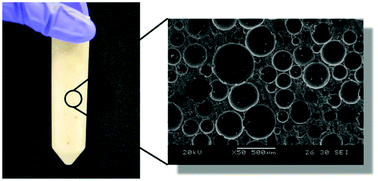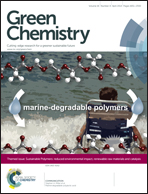Tailored for simplicity: creating high porosity, high performance bio-based macroporous polymers from foam templates†
Abstract
Mechanical frothing can be used to create gas–liquid monomer foams, which can then be subsequently polymerised to produce macroporous polymers. Until recently, this technique was limited to producing low porosity macroporous polymers with poor pore morphology and compression properties. In this study, we show that high porosity (75–80%) biobased macroporous polymers with excellent mechanical compression properties (E = 163 MPa, σ = 4.9 MPa) can be produced by curing of epoxy resin foams made by mechanical frothing. The key to this is to utilise the very viscous nature and very short working time of a biobased epoxy resin. It was found that increasing the frothing time of the biobased epoxy resin reduces the pore diameter of the resulting macroporous polymers. These macroporous polymers were also found to be partially interconnected. The compression properties of the macroporous polymers with smaller average pore diameter were found to be higher than those of foams with larger pore diameters. Unlike emulsion templating, which uses high internal phase emulsions to produce macroporous polymers, called polyHIPEs, the mechanical frothing technique has the advantage of creating macroporous polymers from monomers which cannot be easily emulsified.


 Please wait while we load your content...
Please wait while we load your content...